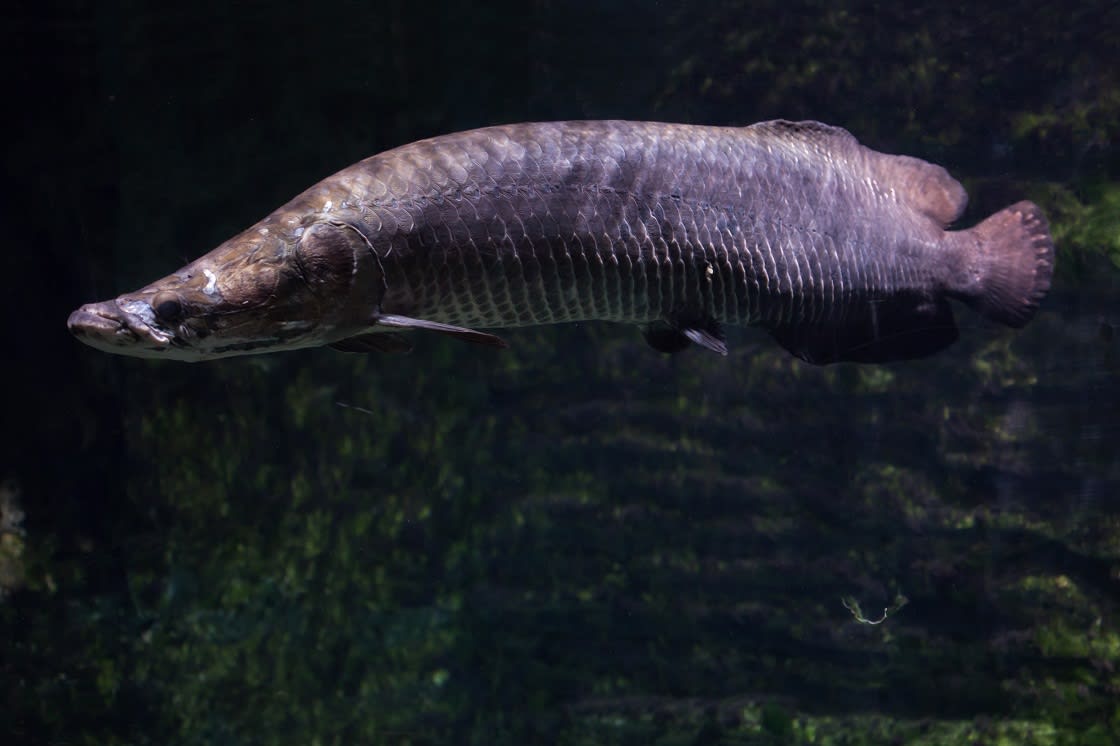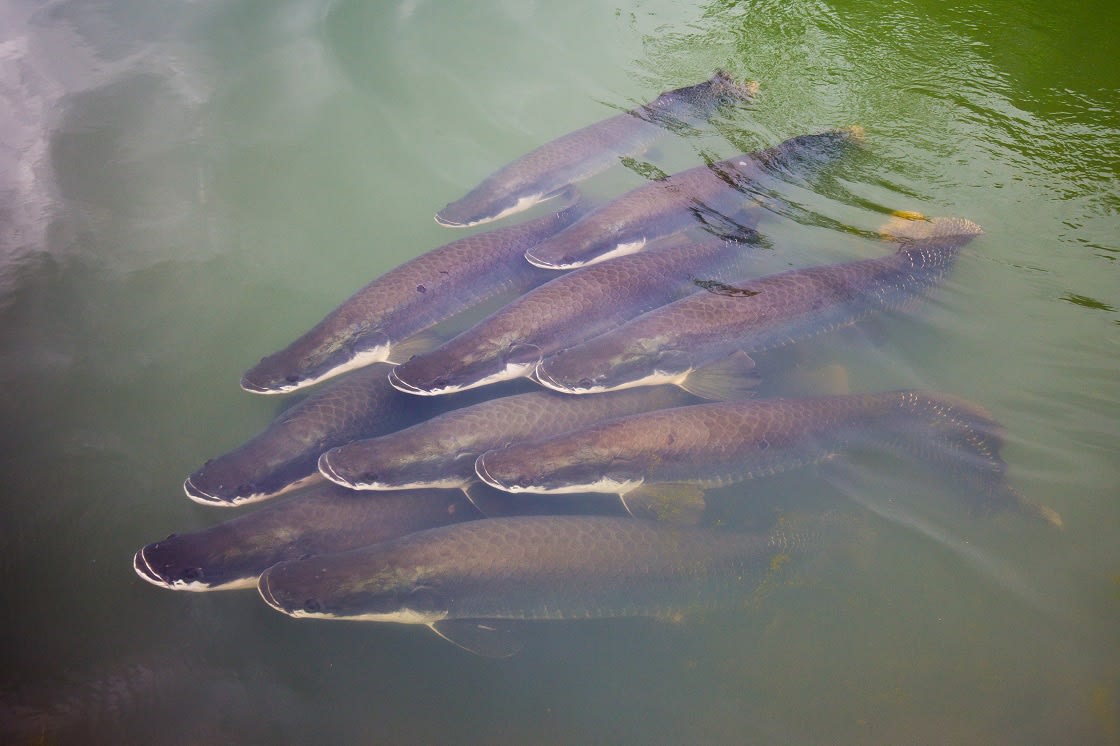
The arapaima is the largest freshwater fish with scales in the world and can be found in the South American tropical waters of the Amazon basin. This massive ‘dinosaur fish’ is essentially unchanged since the Jurassic age and is the inspiration for a local Amazonian legend.
The legend speaks of an evil spirit that inhabits an enormous, scaly fish, taller than a man, that is capable of leaping out of the water to knock fisherman from their boats and crush them with its tongue made of bone. So believable is this legend that the fish was featured on Animal Planet’s River Monsters series, describing it as the Amazon Assassin.

Arapaima, Also Known As The Pirarucu In Brazil
They can truly be monstrous in size. The largest recorded arapaima had a staggering weight of 200 kg (440 lb) and a whopping length of almost 4.6m (15 ft). Owing to over-fishing, large arapaima of more than 2m (6.6 ft) are seldom found in the wild today. However, there are still some monsters out there – take a look at Nat Geo’s Fish Warrior series’ Amazon Giant episode, where the host reels in a huge 10-foot-long specimen, measuring nearly 1.5m (5 ft) in girth and weighing a whopping 147 kg (325 lb)!

A Group Of Young Arapaima
Its local names, paiche (Peru) or pirarucu (Brazil), derive from the indigenous words for “red” and “fish”, on account of its distinctive red markings towards the tail. Streamlined and sleek, with its dorsal and anal fin set back near its tail, it is such a strong and powerful swimmer that it has even been known to jump out of the water. Incredibly similar to a torpedo in shape right? Well, given its power, shape and size, you won’t be surprised to hear it has actually been known to ram prey and predator alike, torpedo-style, with the force of a car crash, and could quite easily knock a fisherman from his canoe!

A Big Arapaima Fish, Also Known As Paiche In Peru
Its self-defense (or attack) capabilities don’t end there. It also has amazing piranha-proof scales. Blackish-green in color, these scales have a highly mineralized, very hard outer layer with a corrugated surface under which lie several layers consisting of collagen fibers. In a structure similar to plywood, the fibers in each successive layer are orientated at right angles to the previous layer for maximum toughness. Despite their toughness, they are still flexible, allowing the fish to remain mobile while heavily armored, meaning it can live in piranha-infested lakes where no other animals could survive. A scientist from the University of California in San Diego is currently looking at using these scales for human technology, with an eye towards applying their secrets to body armor.
Well, not quite steel. They can eat just about anything, though, with their powerful jaws. Their diet typically consists of fish, crustaceans, and – using their ability to jump – they have even been known to snatch and devour birds and monkeys from the water’s surface!
Another incredible feature of the arapaima is its ability to breathe air. That’s right, you heard. Air! Many of the waters in the Amazon are oxygen-deficient (hypoxic), especially at the low-water season and in those oxbow lakes cut off from the main tributaries. As such the arapaima has evolved superbly: in addition to gills, it has a modified and enlarged swim bladder or ‘labyrinth organ’, composed of lung-like tissue, which enables it to extract oxygen directly from the air.
Unfortunately, their ability to breathe air is also a curse. The arapaima has to come to the surface for air every 5 to 15 minutes. This and the fact that it also spends a lot of its time near the water surface for hunting its prey makes it very vulnerable to local fishermen. They are often captured in handheld nets for export or by spearfishing or harpoon for local consumption.
They are also cursed with being very tasty and one of the most sought-after food fish species in South America, often being referred to as the “Cod of the Amazon”. One individual can yield as much as 70 kg of meat. Locals often salt and dry the meat so it can be stored for a long time without rotting, which is very important in a region where few have refrigeration. The tongue of this fish is also thought to have medicinal qualities. It is dried and combined with guarana bark, which is grated and mixed into water. Doses of this are given to kill intestinal worms. In addition, the arapaima’s bony tongue is often used to scrape cylinders of dried guarana, an ingredient in some beverages, and the bony scales are used as nail files or for jewelry.
The ease of fishing and high demand has meant fishermen have been catching large numbers of arapaima since the 1800s, putting populations of the species under severe pressure. Despite a recent increase in community-based schemes for fisheries, their populations are still badly exploited and under some level of threat of extinction, so it is very unlikely that you will come face-to-face with one of these incredible dinosaur fish in the wild. If you do want to come face to face with one, before or after a Peru Amazon River cruise, be sure to visit the Sapi Sapi Pond in Nauta where you can witness and even feed the resident arapaima and other Amazonian fish and turtle species that live there.
While Rainforest Cruises aim to provide accurate and up-to-date information, we make no representations as to the accuracy or completeness of any information herein or found by following any link on this site. Rainforest Cruises cannot and will not accept responsibility for any omissions or inaccuracies, or for any consequences arising therefrom, including any losses, injuries, or damages resulting from the display or use of this information.




